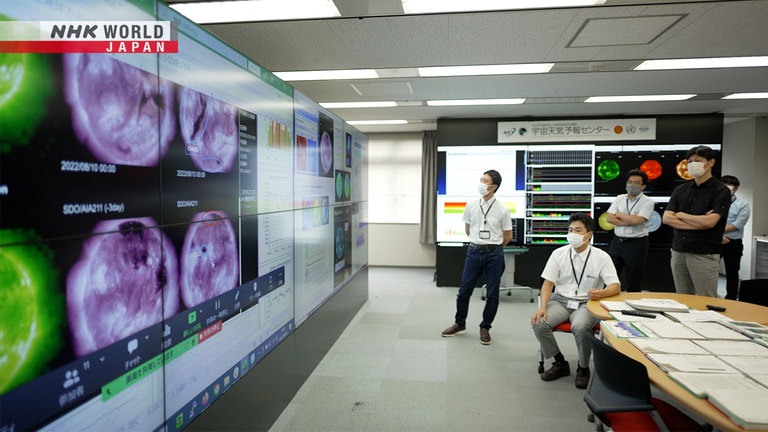#22 Solar Flares
In February 2022, an American space exploration company simultaneously launched 49 satellites. Yet not long after, 40 of those satellites fell out of orbit and burned up upon re-entry into the Earth's atmosphere. Similar accidents have occurred frequently in the past. The cause of such incidents is believed to be solar flares, huge explosions that occur on the sun's surface. Solar flares can also lead to other disasters that threaten our daily lives, such as major power outages, radio interference, and communication problems for airplanes and ships. Why do solar flares occur? We'll visit some researchers in Japan that are working hard to understand their mechanism and predict future occurrences.




Transcript
Japan has a long history of natural disasters.
Now the power of science has helped it to overcome them.
BOSAI
Science that Can Save Your Life In February 2022, SpaceX, the American space exploration company, launched 49 satellites.
However, 40 of them soon fell out of orbit.
Here you can see the satellites burning up, as they re-entered the Earth's atmosphere.
A sudden and unexpected change in the upper atmosphere caused the satellites to stop functioning.
Similar accidents have occurred a number of times in the past.
In 2000, the Japanese satellite ASCA suddenly malfunctioned, and reentered the atmosphere the following year.
And in October 2003, nearly 40 satellites failed or malfunctioned simultaneously.
Why do these accidents keep occurring?
They are thought to be caused by mysterious explosions occurring on the surface of the sun.
Hello, Matthew Chozick here.
Have you heard much about solar flares?
The sun's tremendous energy not only brings vast benefits to us but it also poses some significant risks.
In today's program, we will explore the mysteries of solar storms.
Hello, Professor.
Hello.
Today I'd like to ask you about solar flares.
My first stop was the National Astronomical Observatory of Japan.
In 1990, it installed the world's first telescope for observing these mysterious explosions, or "solar flares."
Dr. Yukio Katsukawa is trying to solve the mystery by combining observations from the ground using telescopes, and observations from space using satellites.
Unfortunately, the day we visited was cloudy, so Katsukawa showed us some observation images from three days before.
Oh wow.
Why do the images have different colors?
There are 3 telescopes, and they observe the sun
by dividing its light into different wavelengths.
First of all, we looked at the green image.
The surface of the sun has a temperature of six thousand degrees Celsius, but sometimes lower temperature areas of about four thousand degrees appear.
These are called sunspots.
Sunspots might be the key to solving the mystery of solar flares.
Sometimes, big explosions, or flares,
occur in these areas.
This is an image of the light emitted by hydrogen, the main component of the sun.
When superimposed on the previous image, we can see bright areas around the sunspots.
Let's look at how a flare occurs.
We looked at the bright area around one sunspot.
Sure enough, we could see the flare occurring in this area.
Examining ultra-high resolution images taken by the HINODE satellite, which Katsukawa was involved in developing, we can clearly see how the flare occurs right next to the sunspot.
What exactly are sunspots?
Sunspots are areas with extremely strong magnetic fields.
The black and white areas represent individual sunspots.
The black area is the south pole, and the white area is the north pole.
In the X-ray image, can you see bright areas
almost connecting the north and south poles?
Yes.
Looking at the X-ray light observed by the satellite, we can see lines that connect the north and south poles.
These are called "magnetic field lines."
A sunspot is the point on the sun's surface where the magnetic field lines emerge from, and re-enter the sun's interior.
What exactly happens to these magnetic field lines to cause a flare?
Observations have not yet revealed this.
So why do solar flares cause disasters on Earth?
The key is the corona, the sun's super-hot outer atmosphere with a temperature of a million degrees or higher.
When a flare occurs, the corona above the sunspot
becomes extremely hot.
The temperature rises tremendously, from about 1 to 10 million degrees,
or tens of millions of degrees.
It was quite high to begin with.
When a flare ocurs,
matter can be seen flying away.
When a flare happens, you can see how
matter is sent flying from the corona.
Giant solar flares cause material from the extremely hot corona to be ejected into space.
The satellites' failures were caused by such material being blown towards Earth.
They can also cause sudden disasters that affect our daily lives, such as major power outages, radio disturbances, and communication failures on planes and ships.
The frequency of solar flares is cyclical, with a peak occurring once every 11 years.
The next peak will be in 2025, so the likelihood of a giant solar flare is increasing.
If a giant solar flare were to hit our planet, what would the impact be?
Here at the National Institute of Information and Communications Technology, they monitor solar flares 24 hours a day, to determine their impact on our lives.
The leader of this project is Kubo Yuki.
When a solar flare causes matter to be ejected into space, what effects does this have?
First, electromagnetic waves such as X-rays,
ultraviolet rays, and radio waves arrive.
This is about 8 minutes after the flare.
Electromagnetic waves from the sun strike the ionosphere, an electrically charged layer of the atmosphere expanding over an altitude range from sixty to one thousand kilometers.
The ionosphere reflects radio waves.
Airplanes, ships and broadcasters use it to send these waves over long distances.
However, the electromagnetic waves from the sun cause disturbances in the ionosphere, resulting in communication problems.
After that, over the next 30 minutes to two days, cosmic radiation will arrive and cause satellites to malfunction.
On the day we visited, there was lots of solar activity with significant cosmic radiation, and Kubo urged caution.
What should people do in this case?
Satellite operators should pay careful attention
to the information, and avoid important operations.
As time passes, even more matter makes its way over.
Two to three days after the flare, a mass of electrically-charged gas, the solar wind, arrives.
Normally, the Earth is protected by the magnetosphere.
But this gust of solar wind can create a "magnetic storm" in the magnetosphere, which may cause huge electrical currents to flow into power lines on the ground.
In 1989, a magnetic storm caused a nine-hour power outage over a large area of Quebec, Canada.
A giant solar flare can paralyze the basic infrastructure that supports our daily lives, such as electricity and communications.
I heard we're entering
an active phase of solar flares.
After observing the sun every day, what do you think?
I've noticed that sunspots have been
gradually increasing these past few years.
So I think the possibility
of a solar flare is increasing.
Huge solar flares can have a massive impact on our modern societies.
Prediction is essential to limiting the damage, but are accurate predictions really possible?
In 2020, Dr. Kanya Kusano of Nagoya University announced the results of new research on the prediction of solar flares, attracting attention from around the world.
How well can we predict solar flares?
Before, we'd been looking at telescope images, and predicting whether a flare is likely to occur
based on the shape and size of sunspots.
Yet very large flares actually occur
about half as often as predicted.
Kusano's approach uses computer simulations to reproduce the mechanism of giant solar flares, which cannot be understood from sunspot observation images alone.
First, the magnetic field of the sunspot is set, with the magnetic field lines emerging from the sun's surface at the north pole, and re-entering at the south pole.
However, a flare would not occur if the energy only builds up here.
When another set of magnetic field lines is added nearby, the magnetic field lines are immediately and violently disrupted.
What is happening here?
If you look closely at the area between the starting point of the first set of magnetic field lines on the left, and the finishing point of the second set on the right, the lines begin to twist.
Eventually, these two points become connected.
At the same time, if we follow the magnetic field lines on the right from their starting point, they connect with those on the left, forming a large arch.
Kusano found that the two near points were connected by short magnetic field lines, and the two far points were connected by long higher-energy lines,
which then fly away in a violent and turbulent manner.
It's between these two near points
that the magnetic field lines are reconnected.
Then the green magnetic field lines
destabilize and fly out into space.
Kusano believes that when a giant solar flare occurs, there is a "reconnection" of the magnetic field lines, somewhere along the boundary line between the north and south poles of the sunspot.
Kusano further developed the simulation to link this theoretical finding to the predictions.
He then developed a computational theory to determine the location of the "reconnection" that might cause a giant flare.
We tried to apply this theory
to actual observations.
Kusano applied his computational theory to observational data of giant solar flares from over the past decade.
He was able to predict seven of the nine giant solar flares.
Now he's working on predicting future occurrences, from one day to a few hours in advance.
The results show that it's possible to predict
precisely where a flare will occur.
Solar flares have an 11-year cycle,
and the next one is due in 2025.
Do you have enough time?
I hope to have it operational as soon as possible,
at least in the next few years.
Although there is an 11-year cycle, the biggest flares don't necessarily occur
when the number of sunspots is at its highest.
Even in periods when the number of sunspots is low,
we must remain vigilant and make precise forecasts.
The next solar flare could happen tomorrow.
Yes, it could.
The sun's natural patterns could damage our human technologies in ways we just can't see.
To protect our way of life here, we have to pay attention to the sun's activities, while better comprehending our place in the universe.